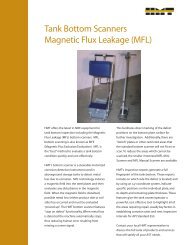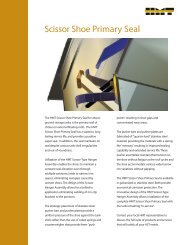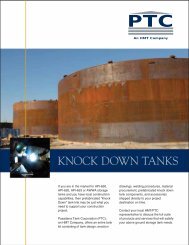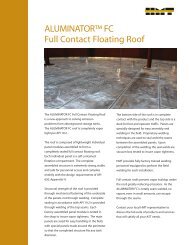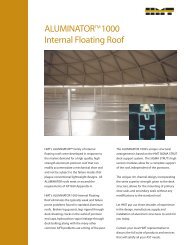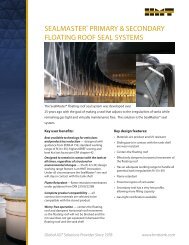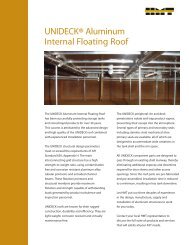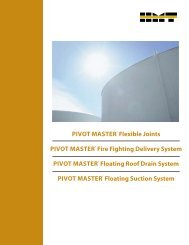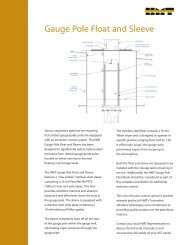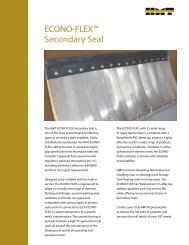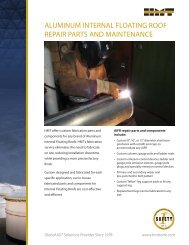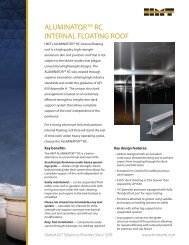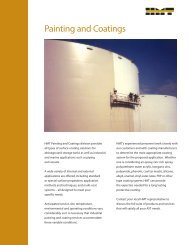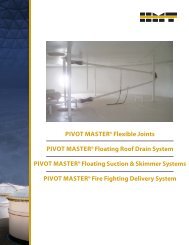Future - HMT
Future - HMT
Future - HMT
Create successful ePaper yourself
Turn your PDF publications into a flip-book with our unique Google optimized e-Paper software.
<strong>Future</strong><br />
refining & storage<br />
Published by<br />
in association with<br />
hcbpublishing<br />
DECEMBER 2012<br />
Refining<br />
● Turnaround for Europe<br />
● Asia drives capacity growth<br />
● Attracting new investors<br />
Storage<br />
● Safety failings identified<br />
● Japan starts rebuilding<br />
● China’s terminals quantified<br />
A special supplement to<br />
and
Tank Roofs<br />
<strong>Future</strong> Refining & Storage<br />
Optimize<br />
capacity<br />
and reduce<br />
heel<br />
Tank operators could be leaving money<br />
on the table every day unintentionally in<br />
storage tanks. This article by Jeff Eickhoff,<br />
General Manager of Sales and Marketing<br />
at <strong>HMT</strong> Inc, addresses strategies to reduce<br />
dead stock and optimise working capacity<br />
in floating roof storage tanks.<br />
30<br />
Drain dry sumps can have significant impacts on dead stock / heel reduction<br />
Dead stock, sometimes referred to as<br />
the ‘heel’, is the minimum inventory<br />
operators are required to maintain<br />
under the floating roof when the roof<br />
is at its lowest operating position. Dead stock,<br />
financially speaking, behaves like non-moving<br />
inventory, tying up working capital. This<br />
inventory cannot be accessed or sold until the<br />
tank comes out of service 10 or 20 years down<br />
the road. Any measure that can be taken to<br />
reduce this dead stock frees up cash to invest in<br />
other areas of the business.<br />
Unfortunately, many design engineers and<br />
procurement managers are either not aware<br />
of the financial impact of dead stock or their<br />
budget structure does not provide a way to credit<br />
them with this add-back to working capital;<br />
therefore they do not take steps to change it. In<br />
some cases, this dead stock is worth millions of<br />
dollars and can be reclaimed with strategies that<br />
in most cases pay for themselves on the first day<br />
the tank is put back into service.<br />
One misconception is that heel reduction<br />
strategies aren’t important if the tank is leased.<br />
However, tanks with less dead stock are more<br />
attractive to lessees, making it easier to lease<br />
tanks in a slower market or even allowing for a<br />
higher lease rate in markets with good demand.<br />
Dead stock reduction<br />
One modification to reduce dead stock is the<br />
installation of a raised bottom (ramped bottom,<br />
or plateau bottom), which displaces much of the<br />
volume of product that otherwise occupies the<br />
space between the floor and the floating roof.<br />
In some cases, the reclaimable heel can amount<br />
to as much as 75%, depending on tank size and<br />
profile of the raised bottom.<br />
The raised bottom is a great solution for<br />
larger tanks, where the ratio of raised area<br />
relative to the perimeter is greater, resulting in<br />
much higher return on investment. If the tank<br />
already requires a bottom replacement, this<br />
option is definitely worthy of review as the cost<br />
becomes incremental to an already planned<br />
maintenance project.<br />
Other factors that should be taken into<br />
account when considering a raised tank bottom<br />
include the water table and site drainage.<br />
Because this option often utilises an asphalt<br />
layer to support the tank bottom, it is imperative<br />
that water is not allowed to get under the<br />
bottom. On sites with frequent standing water<br />
near the tank base, this type of bottom is not<br />
recommended.<br />
While this solution comes at a premium<br />
investment, in tanks larger than 100 feet in<br />
diameter the financial benefit can easily exceed<br />
the investment. Every situation and tank is<br />
unique, so it is important to talk with a tank<br />
consultant or tank contractor and complete a<br />
breakeven and heel reduction analysis.
<strong>Future</strong> Refining & Storage<br />
<strong>Future</strong> Refining & Storage<br />
Tank Roofs<br />
Another modification that can be employed<br />
is a bottom fill system such as a cone-down<br />
centre sump or a perimeter drain dry sump.<br />
This solution, more commonly used in pipeline<br />
facilities, reduces heel by lowering the inlet to<br />
below the tank bottom, thereby eliminating one<br />
of the largest interferences which limits floating<br />
roof travel. This option can help tank owners<br />
achieve significant heel reduction, especially<br />
when used in combination with a suspended<br />
roof.<br />
The bottom fill/drain dry sump may require<br />
additional internal component modifications<br />
in order to obtain the best results. Piping,<br />
supports, columns and other components<br />
will need to be considered when lowering the<br />
minimum liquid level of the tank and the lowest<br />
level obtainable for the floating roof.<br />
This solution can be more economical than<br />
a raised bottom and can also increase working<br />
capacity. However, it may not be ideal for<br />
terminals with frequent freeze/thaw cycles.<br />
Additional, smaller modifications include<br />
relocating nozzles, installing manway plugs<br />
and notching pontoon internal floating roofs<br />
(IFRs). Be sure to consider buoyancy and mixer<br />
operations when notching pontoon IFRs.<br />
Optimising working capacity<br />
Working capacity optimisation can have a big<br />
impact on reducing capital requirements as<br />
well as ongoing maintenance and operating<br />
costs. There are several variables involved<br />
when calculating the capacity of a floating<br />
roof tank. To simplify, these variables are<br />
categorised into three areas: the floating roof<br />
travel constraints at the top of the tank; the<br />
floating roof travel constraints at the bottom<br />
of the tank; and the depth of the floating roof<br />
and seal system.<br />
There are many benefits to optimising<br />
working capacity beyond the obvious<br />
immediate financial impacts. These include<br />
maintenance flexibility, operational efficiencies<br />
and deferred capital costs.<br />
Financially, improved working capacity can<br />
mean increased income-generating capability<br />
of the tank with every cycle.<br />
In certain tank farm settings, extra capacity<br />
means the ability to take a storage tank out of<br />
service with less worry of storage constraints.<br />
Operational efficiencies include the ability<br />
to take larger deliveries at one time, reducing<br />
per-barrel transactional costs. Furthermore,<br />
each additional barrel of storage regained from<br />
a storage tank defers the need for future storage<br />
as the company grows. A new tank farm may<br />
Converting an EFRT to an IFRT can offer several advantages including increased working capacity<br />
even require one fewer storage tank to meet<br />
the capacity requirements when all tanks are<br />
operating at optimal working capacity.<br />
Relocating nozzles and notching pontoons,<br />
as addressed earlier, can help optimise working<br />
capacity. Another fairly easy modification is to<br />
use a secondary seal system that has a lower<br />
profile, allowing higher travel of the floating<br />
roof. In a 100-foot diameter tank, lowering the<br />
secondary seal profile by 8 inches can increase<br />
tank capacity by over 900 barrels per cycle. The<br />
larger the tank, the larger the impact. Moreover,<br />
most secondary seals can be installed while<br />
the tank is in service, allowing capacity gains<br />
without having to wait until the next scheduled<br />
maintenance.<br />
A larger modification with even greater<br />
benefit to working capacity is the replacement<br />
of a steel pontoon IFR with a lower-profile<br />
aluminium IFR. A typical steel pontoon IFR<br />
can range between 22 and 28 inches in rim<br />
depth, whereas a lower profile aluminium IFR<br />
can measure between 12 and 14 inches. The<br />
aluminium IFR can be skin and pontoon or full<br />
contact. However, in order to achieve optimal<br />
working capacity, the use of a suspended IFR is<br />
recommended.<br />
For existing external floating roof tanks,<br />
conversion to an IFR can have significant<br />
impact on working capacity. A traditional<br />
steel pontoon EFR with a typical secondary<br />
seal can be 60 inches in overall system depth.<br />
In comparison, a low-profile aluminium<br />
IFR with a primary seal alone or with the<br />
addition of a low-profile secondary seal can<br />
range from 12 to 20 inches in system depth.<br />
On a 100-foot diameter tank, this can be<br />
the difference of 5,000 barrels in working<br />
capacity per cycle.<br />
Another consideration when striving to<br />
increase working capacity, (discussed in the heel<br />
reduction section), is the implementation of the<br />
bottom fill or drain-dry sump. For every inch<br />
lower in floating roof travel, an inch of working<br />
capacity is gained.<br />
Planning considerations<br />
When making major modifications to a tank,<br />
several key stakeholders should be involved.<br />
Whereas traditional repair and maintenance<br />
projects may involve three or four<br />
stakeholders, major tank modifications for<br />
increased capacity or heel reduction should<br />
include operations/production and possibly<br />
business development and the finance group.<br />
Having preparatory meetings with tank<br />
contractors can help estimate costs, perform<br />
return on investment (ROI) analyses, and<br />
assess all the options.<br />
Advanced planning and timing is crucial<br />
for any tank modifications. Pre-planning with<br />
engineering, tank specialists and operations can<br />
help identify opportunities and help to develop<br />
an operational improvements ‘wish list’.<br />
For major modifications, planning should<br />
start at least a year in advance and must include<br />
involvement and consensus of key stakeholders.<br />
ROI analysis on larger projects, such as the<br />
installation of a raised bottom, a drain dry<br />
sump, or a conversion from EFRT to domed<br />
IFRT will need to be completed prior to budget<br />
season, in order to complete analyses and secure<br />
approvals so proper spending can be allocated.<br />
With a proactive approach and some<br />
advanced planning, the tank maintenance<br />
process can incorporate key modifications,<br />
both large and small, to recapture money tank<br />
operators might be leaving on the table. Discuss<br />
these ideas with a tank consultant or tank<br />
contractor today.<br />
31



